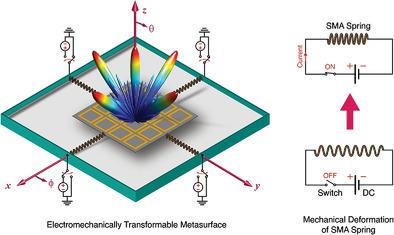当前位置:
X-MOL 学术
›
Adv. Opt. Mater.
›
论文详情
Our official English website, www.x-mol.net, welcomes your
feedback! (Note: you will need to create a separate account there.)
Two‐Dimensional Electromechanically Transformable Metasurface with Beam Scanning Capability Using Four Independently Controllable Shape Memory Alloy Axes
Advanced Optical Materials ( IF 8.0 ) Pub Date : 2020-10-20 , DOI: 10.1002/adom.202001180 Syed Imran Hussain Shah 1 , Anirban Sarkar 1 , Ratanak Phon 1 , Sungjoon Lim 1
Advanced Optical Materials ( IF 8.0 ) Pub Date : 2020-10-20 , DOI: 10.1002/adom.202001180 Syed Imran Hussain Shah 1 , Anirban Sarkar 1 , Ratanak Phon 1 , Sungjoon Lim 1
Affiliation

|
The advancements in wireless technology, especially in radar detection, where accurate target information is critically needed, have set new standards for antenna subsystems that demand higher gain and full scanning coverage in both the azimuth and elevation planes while maintaining lower cost and design simplicity. The conventional phased array usually requires complex feeding circuitry with large spatial occupancy that renders the system bulky and expensive; therefore, a reconfigurable metasurface may be a suitable alternative. Earlier research outcomes have shown different kinds of reconfigurability in designing metasurfaces for beam steering. Designing electrically reconfigurable metasurfaces using PIN diodes, varactor diodes, etc., is a well‐known approach; however, these methods suffer from poor isolation of switches, limited power handling due to nonlinearities, high cost, and complicated biasing networks. This work proposes a novel electromechanically transformable metasurface working as a beam‐steering surface with a wider tuning range in the azimuth plane and a simplified independent switching mechanism. The incorporation of four shape memory alloy (SMA) actuator springs allows swift movements in eight different directions. The electrical control of the pitches of the four springs oriented along the four different SMA axes enables adequate mechanical transformation of the 2D metasurface to obtain beam coverage capability.
中文翻译:

具有四个独立可控形状记忆合金轴的电子束扫描能力的二维机电可变形超表面
无线技术的进步,特别是在雷达检测中,迫切需要精确的目标信息,为天线子系统树立了新标准,这些子系统要求在方位角和仰角平面上都具有更高的增益和全扫描范围,同时又要保持较低的成本和简化设计。传统的相控阵通常需要复杂的馈电电路并占用大量空间,这使系统体积庞大且昂贵。因此,可重构的超颖表面可能是合适的选择。较早的研究结果表明,在设计用于束转向的超颖表面时,存在各种不同的可重构性。使用PIN二极管,变容二极管等设计可电重新配置的超表面是一种众所周知的方法。但是,这些方法的缺点是开关的隔离性差,由于非线性,高成本和复杂的偏置网络,功率处理受到限制。这项工作提出了一种新颖的机电可变形超表面,它可以作为波束转向表面,在方位平面上具有更宽的调谐范围,并具有简化的独立开关机制。包含四个形状记忆合金(SMA)致动器弹簧,可在八个不同方向上快速移动。沿四个不同的SMA轴定向的四个弹簧的螺距的电气控制可实现2D超表面的适当机械转换,以获得射束覆盖能力。这项工作提出了一种新型的机电可变形超表面,它可以作为波束转向表面,在方位角平面上具有更宽的调谐范围,并具有简化的独立开关机制。包含四个形状记忆合金(SMA)致动器弹簧,可在八个不同方向上快速移动。沿四个不同的SMA轴定向的四个弹簧的螺距的电气控制可实现2D超表面的适当机械转换,以获得射束覆盖能力。这项工作提出了一种新颖的机电可变形超表面,它可以作为波束转向表面,在方位平面上具有更宽的调谐范围,并具有简化的独立开关机制。包含四个形状记忆合金(SMA)致动器弹簧,可在八个不同方向上快速移动。沿四个不同的SMA轴定向的四个弹簧的螺距的电气控制可实现2D超表面的适当机械转换,以获得射束覆盖能力。
更新日期:2020-11-18
中文翻译:

具有四个独立可控形状记忆合金轴的电子束扫描能力的二维机电可变形超表面
无线技术的进步,特别是在雷达检测中,迫切需要精确的目标信息,为天线子系统树立了新标准,这些子系统要求在方位角和仰角平面上都具有更高的增益和全扫描范围,同时又要保持较低的成本和简化设计。传统的相控阵通常需要复杂的馈电电路并占用大量空间,这使系统体积庞大且昂贵。因此,可重构的超颖表面可能是合适的选择。较早的研究结果表明,在设计用于束转向的超颖表面时,存在各种不同的可重构性。使用PIN二极管,变容二极管等设计可电重新配置的超表面是一种众所周知的方法。但是,这些方法的缺点是开关的隔离性差,由于非线性,高成本和复杂的偏置网络,功率处理受到限制。这项工作提出了一种新颖的机电可变形超表面,它可以作为波束转向表面,在方位平面上具有更宽的调谐范围,并具有简化的独立开关机制。包含四个形状记忆合金(SMA)致动器弹簧,可在八个不同方向上快速移动。沿四个不同的SMA轴定向的四个弹簧的螺距的电气控制可实现2D超表面的适当机械转换,以获得射束覆盖能力。这项工作提出了一种新型的机电可变形超表面,它可以作为波束转向表面,在方位角平面上具有更宽的调谐范围,并具有简化的独立开关机制。包含四个形状记忆合金(SMA)致动器弹簧,可在八个不同方向上快速移动。沿四个不同的SMA轴定向的四个弹簧的螺距的电气控制可实现2D超表面的适当机械转换,以获得射束覆盖能力。这项工作提出了一种新颖的机电可变形超表面,它可以作为波束转向表面,在方位平面上具有更宽的调谐范围,并具有简化的独立开关机制。包含四个形状记忆合金(SMA)致动器弹簧,可在八个不同方向上快速移动。沿四个不同的SMA轴定向的四个弹簧的螺距的电气控制可实现2D超表面的适当机械转换,以获得射束覆盖能力。











































 京公网安备 11010802027423号
京公网安备 11010802027423号